|
|
|
Sort Order |
|
|
|
Items / Page
|
|
|
|
|
|
|
| Srl | Item |
| 1 |
ID:
088959
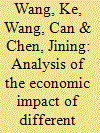

|
|
|
|
|
| Publication |
2009.
|
| Summary/Abstract |
Abatement cost is the main concern for climate change mitigation and the key factor for mitigation cost is technological change. This study established an integrated economic, energy, environmental, dynamic, computable general equilibrium (CGE) model representing endogenous technological change for China's climate change policy analysis. This study analyzed and compared the economic impact of different approaches to mitigation commitments as well as the potential role of technological change in the formulation of mitigation targets and commitments, taking into account China's climate policy-making needs based on the current international climate negotiation process. The results show that, absolute emission limits similar to the Kyoto Protocol will seriously impede the future economic development of China, while the impact of an 80% reduction in carbon intensity, forecast for 2050 based on the 2005 level, is relatively small. Technological change can promote economic growth, improve energy efficiency and reduce carbon intensity per unit of output through the substitution of production factors. Consequently it can reduce marginal abatement cost and related GDP loss by mitigation. At the same time it can increase mitigation potentials and extend the emission reduction amount, showing that consideration of the impact of technological change when deciding the emission reduction targets is necessary
|
|
|
|
|
|
|
|
|
|
|
|
|
|
|
|
| 2 |
ID:
112936
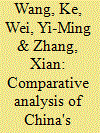

|
|
|
|
|
| Publication |
2012.
|
| Summary/Abstract |
Measuring and improving the energy performance with considering emission constraints is an important issue for China's energy conservation, pollutant emissions reduction and environment protection. This study utilizes several data envelopment analysis (DEA) based models to evaluate the total-factor energy and emission performance of China's 30 regions within a joint production framework of considering desirable and undesirable outputs as well as separated energy and non-energy inputs. DEA window analysis is applied in this study to deal with cross-sectional and time-varying data, so as to measure the performance during the period of 2000-2009. Two treatments for undesirable outputs are combined with DEA models and the associated indicators for simplex energy performance and unified energy and emission performance measurement are proposed and compared. The evaluation results indicate that the treatment of undesirable outputs transformation is more appropriate for China's regional energy and emission performance evaluation because it has stronger discriminating power and can provide more reasonable evaluation results that characterize China's regions. The empirical result shows that east China has the highest and the most balanced energy and emission performance. The energy and emission performance of China remained stable during 2000-2003, decreased slightly during 2004-2006, and has continuously increased since 2007.
|
|
|
|
|
|
|
|
|
|
|
|
|
|
|
|
| 3 |
ID:
125525
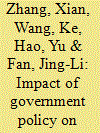

|
|
|
|
|
| Publication |
2013.
|
| Summary/Abstract |
To reduce gasoline consumption and emissions, the Chinese government has introduced a series of preferential policies to encourage the purchase of new energy vehicles (NEVs). However, enthusiasm for the private purchase of NEVs appears to be very low. This timely paper addresses the need for an empirical study to explore this phenomenon by identifying purchase motivations of potential NEV consumers and examining the impact of government policies introduced to promote NEVs in China. A questionnaire survey was carried out. The acceptance of NEVs is measured in three different logistic models: the willingness of consumers to purchase NEVs, the purchasing time, and the acceptable price. The results showed that financial benefits, performance attributes, environmental awareness and psychological needs are the four most important factors influencing consumers' acceptance of NEVs. Among these, performance attributes rather than financial benefits are the most important indicator. The moderating effect of government policies to relations between purchasing intention, time and price is not strong as respected while the policy implications are clear that the 'public awareness of government policy' functions as a moderator in the process of acceptance. These findings could give some hints to the government to make better NEV industry policy.
|
|
|
|
|
|
|
|
|
|
|
|
|
|
|
|
| 4 |
ID:
128047
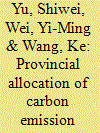

|
|
|
|
|
| Publication |
2014.
|
| Summary/Abstract |
An approach to determine carbon emission reduction target allocation based on the particle swarm optimization (PSO) algorithm, fuzzy c-means (FCM) clustering algorithm, and Shapley decomposition (PSO-FCM-Shapley) is proposed in this study. The method decomposes total carbon emissions into an interaction result of four components (i.e., emissions from primary, secondary, and tertiary industries, and from residential areas) which composed totally by 13 macro influential factors according to the KAYA identity. Then, 30 provinces in China are clustered into four classes according to the influential factors via the PSO-FCM clustering method. The key factors that determine emission growth in the provinces representing each cluster are investigated by applying Shapley value decomposition. Finally, based on guaranteed survival emissions, the reduction burden is allocated by controlling the key factors that decelerate CO2 emission growth rate according to the present economic development level, energy endowments, living standards, and the emission intensity of each province. A case study of the allocation of CO2 intensity reduction targets in China by 2020 is then conducted via the proposed method. The per capita added value of the secondary industry is the primary factor for the increasing carbon emissions in provinces. Therefore, China should limit the growth rate of its secondary industry to mitigate emission growth. Provinces with high cardinality of emissions have to shoulder the largest reduction, whereas provinces with low emission intensity met the minimum requirements for emission in 2010. Fifteen provinces are expected to exceed the national average decrease rates from 2011 to 2020.
|
|
|
|
|
|
|
|
|
|
|
|
|
|
|
|
| 5 |
ID:
111426
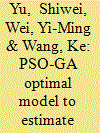

|
|
|
|
|
| Publication |
2012.
|
| Summary/Abstract |
To improve estimation efficiency for future projections, the present study has proposed a hybrid algorithm, Particle Swarm Optimization and Genetic Algorithm optimal Energy Demand Estimating (PSO-GA EDE) model, for China. The coefficients of the three forms of the model (linear, exponential, and quadratic) are optimized by PSO-GA using factors, such as GDP, population, economic structure, urbanization rate, and energy consumption structure, that affect demand. Based on 20-year historical data between 1990 and 2009, the simulation results of the proposed model have greater accuracy and reliability than other single optimization methods. Moreover, it can be used with optimal coefficients for the energy demand projections of China. The departure coefficient method is applied to get the weights of the three forms of the model to obtain a combinational prediction. The energy demand of China is going to be 4.79, 4.04, and 4.48 billion tce in 2015, and 6.91, 5.03, and 6.11 billion tce ("standard" tons coal equivalent) in 2020 under three different scenarios. Further, the projection results are compared with other estimating methods.
|
|
|
|
|
|
|
|
|
|
|
|
|
|
|
|
| 6 |
ID:
118837
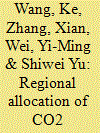

|
|
|
|
|
| Publication |
2013.
|
| Summary/Abstract |
The mitigation efforts of China are increasingly important for meeting global climate target since the rapid economic growth of China has led to an increasing share in the world's total CO2 emissions. This paper sets out to explore the approach for realizing China's national mitigation targets submitted to the UNFCCC as part of the Copenhagen Accord; that is, to reduce the intensity of CO2 emissions per unit of GDP by 40-45% by 2020, as well as reducing the energy intensity and increasing the share of non-fossil fuel consumption, through regional allocation of emission allowance over China's provinces. Since the realization of China's mitigation target essentially represents a total amount emission allowance allocation problem, an improved zero sum gains data envelopment analysis optimization model, which could deal with the constant total amount resources allocation, is proposed in this study. By utilizing this model and based on several scenarios of China's economic growth, CO2 emissions, and energy consumption, a new efficient emission allowance allocation scheme on provincial level for China by 2020 is proposed. The allocation results indicate that different provinces have to shoulder different mitigation burdens in terms of emission intensity reduction, energy intensity reduction, and share of non-fossil fuels increase.
|
|
|
|
|
|
|
|
|
|
|
|
|
|
|
|
|
|
|
|
|